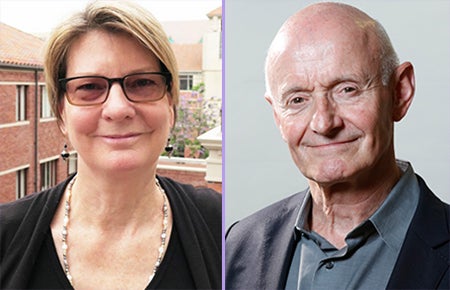
With key elections a year away, California panel study begins testing political waters
“As California goes, so goes the nation.”
Well, sometimes.
The vast majority of national polls infamously predicted that Hillary Clinton would win last year’s presidential contest.
One conspicuous outlier was the USC Dornsife/Los Angeles Times Daybreak Poll, which repeatedly indicated that Donald Trump was running ahead of Clinton in the weeks leading up to the election.
Unlike typical polls, which contact a different sample for each survey, the Daybreak Poll engaged a panel of more than 4,500 people who responded to a survey over 17 weeks. Using this approach, researchers were able to measure a participant’s level of certainty in his or her commitment to vote for a candidate.
The Daybreak poll, part of the Understanding America Study at the USC Dornsife Center for Economic and Social Research (CESR), will now serve as the model for a new survey focused wholly on the state of California.
The new survey will apply the same experimental methodology to observe how the political opinions of California panelists change over time. The focus will be on 2018 midterm elections — elections that feature races for California governor, U.S. Senator, and seven seats that will be critical in the Democratic Party’s efforts to flip the House of Representatives blue.
Arie Kapteyn, professor (research) of economics and director of CESR, said the California survey is a natural follow-up to the Daybreak poll. As the nation’s most populous, diverse and economically influential state, heads often turn west when anticipating the future.
“We will use this to check the pulse of California — to see what moves people, what their concerns are, and their political preferences,” Kapteyn said.
Practical partnership
Part of an expanded collaboration with CESR, the USC Dornsife Jesse M. Unruh Institute of Politics and the Los Angeles Times, initial results of the project will be published in a series of stories beginning on Nov. 9. It will establish benchmarks upon which the growing panel’s opinions will be measured in the months leading up to next year’s midterm elections.

Jill Darling, left, and Arie Kapteyn of USC Dornsife’s Center for Economic and Social Research.
CESR staff were eager to partner with their Unruh Institute colleagues for design and analysis of the California survey. Led by Carmen Warschaw Professor of Practical Politics Robert Shrum, the Unruh Institute takes an academic approach to understanding California’s distinct sociopolitical ecosystem. It has well-developed inroads to Sacramento and provides an insider’s perspective on high-level policy issues.
“We work together really well,” said Kapteyn. “For the California poll, the content will largely come from Unruh. Our main role is to take care of the implementation, give advice on how to formulate a question, and interpret the sample.”
Among the issues the California surveys will benchmark are attitudes on the governor’s race, state immigration policy, populism, information deserts, and whether California should be forging its own way on issues such as sustainability and the environment.
Jill Darling, survey director at CESR, said it starts with discussions between experts at CESR and Unruh on which statewide issues they would like to better understand.
“We are trying to leverage all of this knowledge and curiosity and different ways of looking at the problems we have,” Darling said. “We want to look beyond what people are saying about the typical questions of job approval and whom they are voting for to find out what’s really driving them.”
Stories behind the numbers
Both Kapteyn and Darling emphasized that building a new survey is a challenging endeavor. Not only are there significant costs in establishing a representative sample, but there is also rigorous evaluation of the way questions are framed to eliminate as much bias as possible.
Darling also maintains that a big consideration survey researchers grapple with today is how to communicate results in a way that is both useful in a media setting and also takes fully into account the prognostic aspect of predictive data.
“It’s not an oracle stating from on high that this is the truth. It’s our best estimate within a certain level of confidence,” said Darling. “And it’s very hard to communicate that when a number looks like a hard and fast fact.”
She should know. The Daybreak Poll that Darling helped design incited rancor in the weeks leading up to the presidential election. Calbuzz, a popular online political commentary site, called it a “world class flapdoodle” and said it dishonors the newspaper.
Will Californians react similarly to results of the new survey that might appear unpopular? Or has the Daybreak poll earned its bona fides?
“It’s easy to say [the results] are within the margin of error, but having that actually come across and be part of the dialogue is an ongoing struggle,” said Darling. “It has become even more crucial now to figure out a way to get that into the discourse somehow.”
Shrum says this challenge of communication is something the Unruh Institute can help address.
“Politics is all about the messages we use to influence decisions. Sometimes those messages don’t get through, or they get messy,” he said. “Part of what we do at Unruh is make unbiased examinations of what is at the core of a politician’s idea. Then we try to clarify that idea within civil and fact-based conversations the public can understand.”